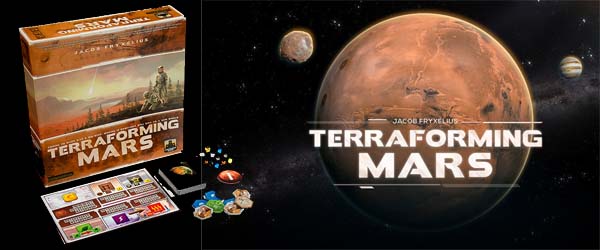
Steam recently released a digital version of the board game Terraforming Mars. I haven't played the digital version (which is getting "mixed" and negative reviews at the time of this writing), but I have played the board game version. It's pretty fun, and in celebration of the latest NASA probe landing on the surface of Mars, I thought I'd launch a review of the board game.
Terraforming Mars has a wide variety of gameplay mechanics, which makes it kind of difficult to clearly categorize it. It also makes it a little difficult to teach the game to new players efficiently. It's not an overly-complicated game, however. It's just a lot of different concepts that you have to explain. Regardless, I've been able to get through learning games with new players in about three or three-and-a-half hours (including the rules explanation). So it's not overly burdensome to learn and play. It's also not terribly hard to simply play a sample round to teach the game flow, and then mulligan the game if any players feel they dug themselves into a hole.
Terraforming Mars has multiple distinct mechanics, ranging from tableau-building to tile-placement.
There's tile placement with adjacency bonuses. There's resource management. There's action economy. There's a little bit of tableau building and hand management. There's even a certain degree of bluffing. Playing with the non-basic corporations adds variable player powers, You can even optionally play with card drafting! Pretty much the only thing that we're not doing is loyalty / betrayal mechanics. Despite including so many varying game mechanics, nothing feels out of place, and everything fits together well.
The rulebook includes footnotes explaining the scientific basis for the rules and mechanics.
Depending on how you play, however, the actual game board and your tableau of cards can sometimes feel very disparate. If you're not actively placing tiles on the board, then the whole board can pretty much boil down to a score and prerequisite tracker. However, if you're avoiding placing tiles on the board, then you're probably going to lose, as I've yet to see a predominantly card-based strategy win the game.
The board itself includes a map of Mars' surface, and has notable landmarks on Mars clearly labeled. Unfortunately, the board only covers one half of Mars' surface, so there's some notable landmarks that are not included at all (perhaps the other side of the planet is an expansion?). The resource cubes are very shiny and pretty, and have an appropriately sci-fi aesthetic to them. The rulebook also includes little footnotes that explain some of the scientific bases for the game's rules and mechanics. it's like the kind of thing you might expect if Neil DeGrasse Tyson wrote a board game. Science and space nerds will probably really appreciate these efforts at scientific accuracy.
The resource cubes are pretty, but shift around very easily on the flimsy, card stock economy boards.
Other components besides the resource cubes are kind of cheap and flimsy though. The player economy boards are printed out on basic card stock. There aren't any slots or grooves for the production cubes to sit in, so they slide around very easily if the table is jostled, or if the economy board is shifted around. You may want to invest in some third-party replacements or overlays in order to solve this problem.
The box also doesn't have any inserts of any kind for storing components -- just a handful of plastic, zip-lock bags. They expect you to just drop all the cards in a plastic baggie and just toss them in the box haphazardly along with all the other pieces!
At a price point of $70 (USD), I expect more from a game's components! Fortunately, where the game lacks in production value, it more than makes up for in entertainment value!
... [More]
ef527080-aedf-4583-a72d-8d6ee9108d4f|0|.0
Tags:Terraforming Mars, Stronghold Games, Jacob Fryxelius, board game, Mars, space, science fiction, terraforming, technology, hex, tile, city, forest, ocean, temperature, oxygen, victory points

Obviously, I love the Sid Meier's Civilization game franchise. I've been playing it since Civ III, and even own the Fantasy Flight board game (which I also really like). This game series has kept me up, one-more-turning, into the wee hours of the morning on many occasions. Despite my love for the games, this series can also really grind my gears sometimes.
One of my persistent frustrations with the Civilization series of games is the way that it handles difficulty levels. Granted, this seems to be a common issue in all strategy games, so Civ is certainly not unique in this frustration. Basically, the higher difficulties don't make the A.I.s play better; rather, it just gives them free stuff at the beginning of the game, and buffs their production, research, and so on. The free stuff includes (depending on the difficulty level selected): extra settlers, extra military units, free workers/builders, free technologies, extra gold, extra population in its starting city, and so forth.
There's three key problems with this design paradigm:
- It front-loads the challenge in a game that is supposed to have very long play-sessions
- It limits player options
- It rushes the pace of the game
The front-loading of frustration
Giving the A.I.s extra stuff at the beginning of the game only makes the game harder by giving the A.I.s a handicap - a head start. It doesn't make the A.I.s better - or the game harder - in the long run. The A.I.s still chose crappy locations for those extra settlers to plant their cities - often putting them in un-productive locations, or (in the case of Civ VI) putting them so close together that they can't fit enough districts in. The A.I. doesn't plan ahead regarding where its districts will be, and it often places those districts in sub-optimal locations. "Sub-optimal" being an understatement.
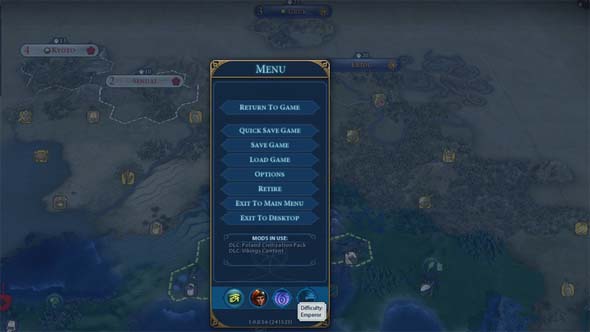
The A.I. starting with extra settlers on high difficulties doesn't make the game harder in the long run.
Those free extra units aren't used more effectively either. Even with a few extra warriors, the A.I. still can't plan or execute a city siege, as it's generally inept at handling the one-unit-per-tile, hex-based combat, and they rarely bother to escort their civilian units. The developers can't be completely blamed for this, as A.I. for tactical combat is a very difficult problem to solve. Most games that have A.I.-driven tactical combat either don't have any grand strategy at all (as in Panzer General), or the grand strategy is separated into a completely different layer of gameplay (as in Total War).
Once the human player can get his or her cities up and running, get a sizable military built, and start conquering the A.I., all these free starting units become moot. These extra units can even backfire. A.I. cities can usually easily be captured by the human player. Since the A.I. gets buffs towards population growth, production, and other yields, those cities tend to grow faster than the player's cities anyway. So if they're conquered, then the human player gets better cities than they could have founded on their own, and gets them sooner than if they had spent the time to build their own settlers.
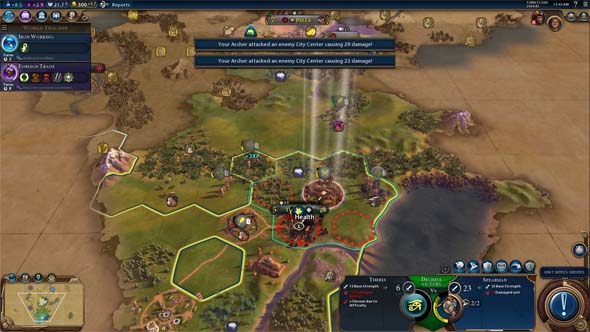
It's not hard to capture A.I. cities, which are often larger and more developed
than any city the player could have founded within the same amount of time.
These early hurdles aren't that difficult to overcome, and once the A.I.'s starting advantages have been neutralized, they don't pose much of an increased threat long-term... [More]
a8515e12-0c08-4e01-a801-df49acf76d91|5|5.0
Tags:Sid Meier's Civilization, Civilization V, Civilization VI, Firaxis, strategy, grand strategy, difficulty, tactics, artificial intelligence, hex, handicap, wonder, eras, technology
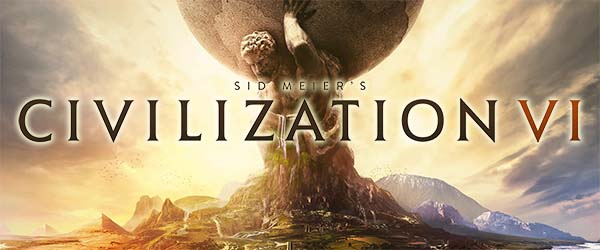
Firaxis has given me a belated birthday gift by releasing Civilization VI. They've also ensured that I don't get very much productive done during the months of October and November this year, since I've been sinking a whole lot of time into "one more turn"-ing myself late into the night. I've barely scratched the surface of the newly-released Dark Souls III DLC, my Madden franchise has fallen behind, and I haven't even bothered buying recently-released games like the new Master of Orion. My board game collection has been collecting dust, and my Dungeons & Dragons campaigns have been on hiatus. I'll get back to all those things after one more turn.
Oozing with production quality
The first thing that stood out to me upon entering my first game was the artwork. It's a pretty stark contrast from Civilization V's visuals. Civ V favored a semi-photo realistic quality. Many screenshots of the game's map look like satellite photos, and units (though exceedingly large) looked and animated realistically. This created a lot of pretty screenshots (still images), but the game looked kind of static, washed-out, and dull in motion. VI, on the other hand, goes for an exaggerated, vibrant, and more cartoonish look that reminds me a lot more of Civ IV and Civ Revolution.
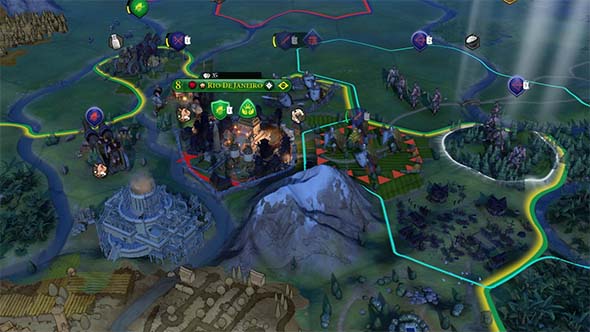
The graphics are vibrant and highly informative. Everything that you see on screen genuinely means something.
What I really like is how utilitarian the visuals are. Almost everything on the game map is communicating part of the state of the game to the player. You can see every piece of infrastructure in and around a city, as well as exactly which tiles are being worked, all without having to open a separate screen and without having to clutter the screen with extra UI icons. There's even different graphics to represent the different phases of a building or wonder's construction that tells you exactly what that city is currently constructing, and how close it might be to finishing that wonder. It's attractive, but it's also clean and informative.
The fog of war is also wonderfully functional and neat to look at. This game renders the fog of war with the style of a hand-drawn map on canvas (similar to Total War: Shogun 2, which I loved). Heck, there's even an animated day/night cycle that was seemingly added because ... why not?
Improvements have different graphics for when they're un-worked [LEFT] versus worked [RIGHT].
The rest of the game shows similarly high production quality. There's actual cinematics for the win screens instead of dialogue boxes with a static image. Finishing a wonder results in an in-game cutscene of that wonder's construction. It isn't quite as pretty as Civ IV's pre-rendered wonder movies, but makes up for it by providing a sense of context that makes me feel like I'm seeing "my Oracle" instead of just the Oracle. There's more historic quotes, all of which are narrated wonderfully by Sean Bean. Firaxis even brought back composer Christopher Tin for some of the music. The new theme music, "Sogno Di Volare" ["The Dream of Flight"] isn't as immediately catchy as "Baba Yetu", but it's still an uplifting, memorable track that stands out more than the menu themes of Civ V. Put simply, this game just looks and sounds terrific... [More]
b970ea1d-5fb2-48fe-9374-28eaf71e348a|2|5.0
Tags:Sid Meier's Civilization, Civilization VI, civilization, strategy, grand strategy, turn-based strategy, history, humanism, humanist, Civilopedia, city, empire-building, districts, hex, civic, social policy, diplomacy, Ed Beach, Christopher Tin, Sean Bean

Civilization VI may look very similar to Civilization V at a glance, but once you start playing it, you're going to notice a lot of subtle differences. One of the most immediate differences will be the changes to unit-movement rules with respect to terrain. Units still travel on hexes, and terrain such as hills and forests still slow down movement, just as in the previous game. But this time around, the cost to enter a tile must be paid before entering that tile! This is a small, but significant change of rules that may force you to change the way that you explore the map.
The rewards of exploration are many, and finding these rewards is key to a good start.
Efficient exploration is key to getting off to a good start in Civilization. And a good start is key to success at higher difficulties and in competitive multiplayer. This is still true in Civilization VI. First and foremost, exploration will reveal valuable real estate for settling your first few cities, including resources, coast lines, and natural wonders. An efficient explorer will also be likely to uncover more tribal villages (i.e. "goody huts"), which will grant tech boosts, extra money, free units, or a head start towards founding your own pantheon. Efficient exploring will also introduce you to more city states, and you'll be more likely to be the first player to meet the city state. Being first to meet a city state will grant you a free envoy. This will grant you an immediate bonus depending on the type of city state, and it will put you one step closer to unlocking additional bonuses and becoming the suzerain of that city state.
So now that we've seen the rewards and benefits that await our exploration of the map, let's take a look at those new movement rules and how they'll impact our early exploration... [More]
34003f4c-d37b-4dae-b69d-b6175f32dc49|1|5.0
Tags:Sid Meier's Civilization, Civilization VI, unit, movement, hex, exploration, hill, forest, jungle, river, terrain, scout, warrior, city, city state, suzerain, natural wonder, ancient ruin, eureka, barbarian, encampment, pillage
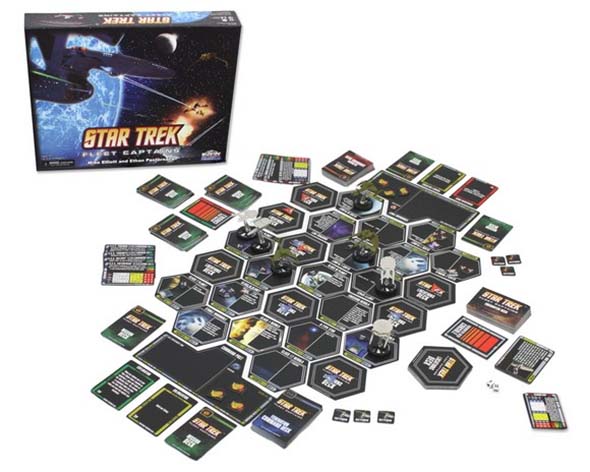
Star Trek: Fleet Captains is an exploration and combat board game by WizKids.
Good Star Trek games are few and far between. That goes for both video games and board games. Part of the reason for this is that it's often difficult to capture the spirit of Star Trek when trying to adapt it into en existing game genre. This is why Trek-themed games end up turning into dull shooters or tactical combat games. Games about exploration or scientific discovery, or role-play are sadly uncommon in video game formats (which is what makes 1999's PC game Birth of the Federation stand out to me as an underrated Trek classic). Sure it was just a reskin of Master of Orion II, and it had lots of technical and A.I. flaws, but in a market dominated by cookie-cutter games like Star Trek: Armada, Elite Force, and Invasion, Birth of the Federation was a rare game in which "exploring strange new worlds" and "seeking out new life and new civilizations" was a primary game mechanic.
Board games and table-top games have maybe fared a bit better than video game adaptations. We have our Dungeons & Dragons-inspired role playing games, our tactical starship simulators, and then countless board game reskins (ranging from Monopoly to Settlers of Catan, and virtually everything in between). Most of these games are pretty old, but there's also a handful of newer Star Trek games that run the gamut. One such game is WizKids' Star Trek: Fleet Captains.
WizKids is probably best known for its Mage Knight and Hero Clix miniatures games based on fantasy, video game, and comic book characters. The bases for these figures include a rotating dial that allows the player to change the attributes of the character to one of several pre-set values. This can include altering their combat attack power, hit points, mana, or any other value that the specific game might require. Fleet Captains uses a similar clix system as the backbone of its starship management mechanics.
Unboxing impressions
My first impressions upon opening the box was a bit disappointing. I'm not a big fan of the ship miniatures. They're fairly well-detailed and made out of a sturdy plastic and seem like they should stand up to a lot of play, but that's the only thing that I like about them. They take up a lot of space, making it difficult to cram more than two or three ships on any single hex. There seems to have been some effort made to scale the size of the Federation ships with one another, but it isn't consistent. Voyager, for example, is almost as large as the Enterprise E, but the Enterprise A and Reliant are noticeably smaller and appear decently-scaled against the Galaxy class Venture. Klingon ships, however, seem to have no effort put into trying to appropriately scale them. Birds of Prey and classic cruisers look huge compared to most Federation ships and to other Klingon ships. The Negh'var, despite being one of the largest ships in the game, just doesn't seem as massive and intimidating as it should be.
Despite the manual showing painted miniatures in its components list [LEFT],
the actual miniatures [RIGHT] are unpainted and not to-scale with one another.
The ships are also all are made of the same mono-chrome plastic and are un-painted (even though the instructions appear to show painted miniatures in the components list). These ships are different enough in design that it's really not hard to tell them apart, and so I see no reason why they couldn't have been painted (as opposed to being the same color for ease of recognition)... [More]
b4ed0de9-dad0-40a2-8fb7-fdfa4f9f20d1|2|3.0
Tags:Star Trek, Star Trek: Fleet Captains, starship, board game, miniatures game, Hero Clix, WizKids, victory points, hex, exploration, Mike Elliot, Ethan Pasternack
|

| 12 | | | | | | | 60 | | 11 | | | | | | | 55 | | 10 | | | | | | | 50 | | 09 | | | | | | | 45 | | 08 | | | | | | | 40 | | 07 | | | | | | | 35 | | 06 | | | | | | | 30 | | 05 | | | | | | | 25 | | 04 | | | | | | | 20 | | 03 | | | | | | | 15 | | 02 | | | | | | | 10 | | 01 | | | | | | | 05 |
|